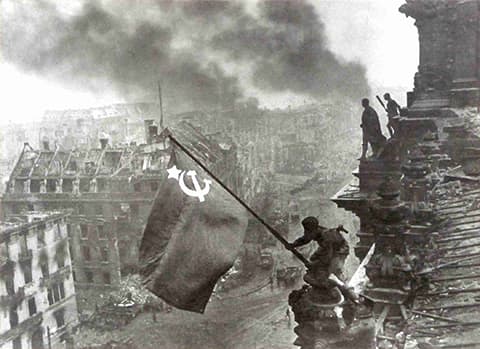

All images, courtesy Bonhams
Ukranian-born photographer Yevgeny Khaldei captured the famous image of Russian soldiers hoisting the Soviet flag over the Reichstag in Berlin, Germany, in May 1945.
Khaldei used a Leica III, according to Bonhams, which will auction the camera in Hong Kong in November.
It is expected to fetch £230,000-£340,000.
Khaldei, who worked for Soviet news agency TASS, restaged the moment when Red Army fighters had first flown the flag over the Reichstag building two days earlier, before the Germans dislodged them.
Bonham’s head of scientific instruments Jon Baddeley said: ‘It is a great privilege to be selling a camera with such evocative associations.
‘Raising a flag over the Reichstag is a defining image of victory over evil that affected people deeply at the time and has continued to resonate for later generations.’
A Bonham spokesman added: ‘The soldiers in Khaldei’s photograph are not the original men and the image has been altered to add more smoke…’
The image became one of the most reproduced images in the world, its significance compared to Joe Rosenthal’s ‘Raising the Flag on Iwo Jima’.
Captured a few months earlier, Rosenthal’s photo depicted US soldiers’ victory in the Pacific, serving as a morale-booster for the American public.
‘Khaldei was familiar with the image and knew that a similarly important photograph could be created in the ruins of Berlin,’ wrote David Clark in a feature for Amateur Photographer (AP) in 2012.
‘However, he faced a practical problem: the Red Army had no flags of a suitable size to make an impact in a photograph, so, as the battle continued, Khaldei returned to Moscow to look for some.

Yevgeny Khaldei [image, courtesy Bonhams]
‘This search proved difficult in the limited time available, so he improvised by borrowing three red tablecloths, reputedly from the TASS agency office.
‘To transform the tablecloths into flags, Khaldei’s uncle, a tailor, sewed the Soviet hammer, sickle and star onto the material.
‘Khaldei (pictured above) flew back to Berlin and photographed the flags after placing them in prominent positions around the city – one at an airport in front of a Nazi symbol and another on top of the Brandenberg Gate. The third was saved for the Reichstag, a major building that had been constructed in 1894 to house the German parliament. Although it had fallen into disuse after a fire in 1933, it had a symbolic significance recognised by both sides.’
On 30 April 1945, Red Army troops gained the upper hand and placed a Soviet flag on top of the building. However, there was no photographer present to record the event at the time.
‘A German soldier removed the flag the next day, but the Soviets achieved complete control of the Reichstag on 2 May.
‘This was the cue for Khaldei to set up his picture. He asked some soldier colleagues to hoist the flag on top of the building with the ruins of Berlin in the background and, with his Leica, shot several images from different angles,’ reported AP.
‘From the 36 exposures he shot that day, one stood out as having the necessary epic qualities to encapsulate the German defeat.’
By comparing different versions of the image, it can be seen how dark smoke was later added to the image (pictured above), seemingly to add drama to the scene.
Further editing took place before it was published, reportedly to remove a watch worn by one of the soldiers, because it was believed to have been looted.








